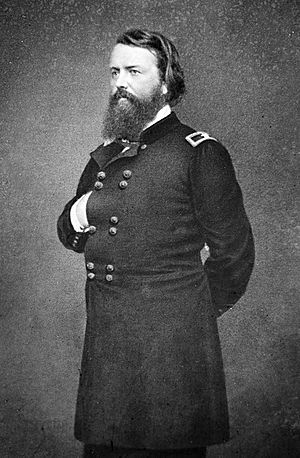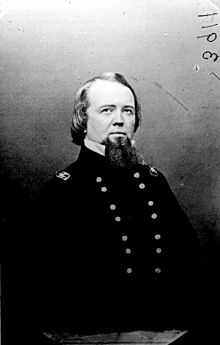John Pope (military officer) facts for kids
Quick facts for kids
John Pope
|
|
|---|---|

Brig. Gen. John Pope
|
|
| Born | March 16, 1822 Louisville, Kentucky |
| Died | September 23, 1892 (aged 70) Ohio Soldiers and Sailors Home near Sandusky, Ohio |
| Place of burial | |
| Allegiance | |
| Service/ |
United States Army Union Army |
| Years of service | 1842–1886 |
| Rank | |
| Commands held | Army of the Mississippi Army of Virginia Department of the Northwest Department of the Missouri Military Division of the Pacific |
| Battles/wars | Mexican–American War Apache Wars |
John Pope (born March 16, 1822 – died September 23, 1892) was an officer in the United States Army. He became a Union general during the American Civil War. He is most remembered for his big defeat at the Second Battle of Bull Run in the East.
Pope graduated from the United States Military Academy in 1842. He fought in the Mexican–American War. He also worked as an engineer and surveyor in places like Florida and New Mexico. Before the Civil War, he spent many years mapping possible routes for the first transcontinental railroad.
When the Civil War started, he quickly became a brigadier general. He had some early success in the West. He captured Island No. 10 on the Mississippi River. This victory impressed President Abraham Lincoln. Lincoln then brought him to the East to lead the new Army of Virginia.
In the East, Pope upset many of his new officers and soldiers. He publicly said their past efforts were not as good as his Western command. He then led his army against the Confederate army of General Robert E. Lee. Lee outsmarted Pope, sending Maj. Gen. Stonewall Jackson behind Pope's army.
At the Second Battle of Bull Run, Pope focused on attacking Jackson. But another Confederate general, Maj. Gen. James Longstreet, attacked Pope's side. This surprise attack caused Pope's army to be completely defeated.
After this major loss, Pope was sent far away from the Eastern battles. He went to Minnesota to command U.S. Forces in the Dakota War of 1862. Later, he commanded the Department of the Missouri. He also played an active role during the Reconstruction period in Atlanta. For the rest of his military career, he fought in the Indian Wars. He fought against groups like the Apache and Sioux.
Contents
Early Life and Career
John Pope was born in Louisville, Kentucky. His father, Nathaniel Pope, was a well-known judge in Illinois. He was also a friend of Abraham Lincoln. John Pope graduated from West Point in 1842. He was 17th in his class.
He started as a second lieutenant in the Corps of Topographical Engineers. He worked in Florida and helped map the border between the U.S. and Canada. During the Mexican–American War, he fought under Zachary Taylor. He earned promotions for his bravery at the Battle of Monterrey and Battle of Buena Vista.
After the war, Pope surveyed land in Minnesota. He showed that the Red River could be used by boats. From 1851 to 1853, he was the chief engineer in New Mexico. He spent the next few years surveying routes for the Pacific Railroad.
Civil War Service
When Abraham Lincoln became president, John Pope was one of four officers chosen to escort him to Washington, D.C.. On June 14, 1861, he was made a brigadier general of volunteers. He was sent to Illinois to help recruit soldiers.
In the West, Pope commanded forces in Missouri. He had some disagreements with his commander, Maj. Gen. John C. Frémont. Frémont believed Pope was not following his orders. Historians suggest Pope might have been more timid than disloyal.
Pope eventually forced Confederate forces under Sterling Price to retreat. He captured 1,200 prisoners in a small battle in December. Pope was known for boasting, but his minor victory got the attention of Maj. Gen. Henry Halleck.
Halleck put Pope in charge of the Army of the Mississippi in February 1862. Pope was given 25,000 men to clear Confederate blockades on the Mississippi River. He surprised the Confederates by marching on New Madrid, Missouri, and capturing it in March.
He then planned a clever attack to capture Island No. 10. This was a strong fort with 12,000 soldiers and 58 cannons. Pope's engineers dug a channel to go around the island. With help from gunboats, his men landed on the other side. This trapped the Confederate defenders. The island surrendered on April 7, 1862. This opened up the Mississippi River for Union ships all the way to Memphis.
Pope's success on the Mississippi earned him a promotion to major general. He was then called to the East by President Lincoln. This happened after Maj. Gen. George B. McClellan's Peninsula Campaign failed. Pope was given command of the Army of Virginia. This new role made Frémont so angry that he resigned.

Pope arrived with a lot of confidence, which some Eastern soldiers found annoying. His army grew to 70,000 men with new units. But Pope's aggressive style was not enough against Confederate General Robert E. Lee. Lee had a smaller army (55,000 men). He decided to split his forces. He sent Maj. Gen. Stonewall Jackson with 24,000 men to distract Pope. Jackson defeated Pope's officer, Nathaniel Banks, at Battle of Cedar Mountain.
As Lee moved towards Pope, Jackson went around to the north. He captured Pope's main supply base at Manassas Station. Pope was confused and couldn't find the main Confederate army. He then fell into a trap at the Second Battle of Bull Run. His soldiers fought hard against attacks from Jackson and Lee on August 29, 1862.
But the next day, Pope made a mistake. He ordered Maj. Gen. Fitz John Porter to attack Jackson. This left Porter's side, and the whole Union army's side, open. Maj. Gen. James Longstreet launched a surprise attack on their side. The Union Army was badly beaten and had to retreat. Pope became even more unpopular. He blamed his defeat on Porter, who was later found guilty by a military court.
Pope was removed from command on September 12, 1862. His army was combined with McClellan's Army of the Potomac. He spent the rest of the war in Minnesota. There, he dealt with the Dakota War of 1862. His time in the West helped his career. He was promoted to major general in the regular army for his service at Island No. 10.
In 1865, Pope became commander of the Department of the Missouri. After the Civil War ended, Pope offered Confederate General Edmund Kirby Smith the same surrender terms that Grant gave to Lee. Kirby-Smith refused at first, but his army surrendered five weeks later.
After the War
In April 1867, Pope was made governor of the Reconstruction Third Military District. His office was in Atlanta. He issued orders that allowed African Americans to serve on juries. He also postponed elections and banned city ads in newspapers that did not support Reconstruction. President Andrew Johnson removed him from this command in December 1867.
Pope then returned to the West. He commanded the Department of the Missouri until 1883. This was the second-largest military command in the country. He served well in the Apache Wars. He helped move Southern Plains tribes to reservations in Oklahoma. Pope believed the military should manage the reservation system, not the Indian Bureau, which he thought was corrupt. He also spoke out for better treatment of Native Americans.
In 1879, Pope's reputation was hurt. A new investigation looked into the Second Battle of Bull Run. This investigation, led by Maj. Gen. John Schofield, found that Fitz John Porter had been wrongly convicted. The report said that Pope himself was mostly to blame for the Union loss. It described Pope as reckless and not well-informed during the battle. It also said Porter's actions actually helped save the Union army from total disaster.
Pope was promoted to major general in the Regular Army in 1882. He then commanded the Military Division of the Pacific in 1883. He stayed in this role until he retired.
Later Life and Legacy
John Pope retired as a major general on March 16, 1886. His wife, Clara Pope, passed away two years later. His memories were published in a newspaper called the National Tribune between 1887 and 1891.
General Pope died on September 23, 1892, at the Ohio Soldiers' Home near Sandusky, Ohio. He is buried next to his wife in Bellefontaine Cemetery in St. Louis, Missouri.
Images for kids
See also
 In Spanish: John Pope para niños
In Spanish: John Pope para niños
- List of American Civil War generals (Union)
- The Court-martial of Fitz John Porter


